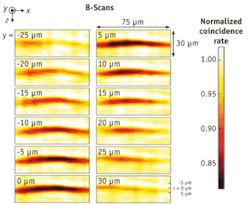OPTICAL COHERENCE TOMOGRAPHY TECHNOLOGY: Quantum OCT images biological sample
For the first time, quantum optical coherence tomography (QOCT)1 has been proved viable for imaging biological samples. M. Boshra Nasr, a postdoctoral researcher in Boston University’s Quantum Imaging Laboratory led the work that has produced the first such experimental QOCT images.
The approach is appealing because, unlike classical OCT, QOCT is inherently immune to group-velocity dispersion (GVD), which degrades the axial resolution. This immunity is a result of the frequency entanglement inherent in the light source.2 QOCT is a fourth-order interferometric optical-sectioning scheme that makes use of frequency-entangled photon pairs that are generated via the process of spontaneous optical-parametric downconversion (SPDC). By contrast, conventional OCT is a second-order interferometric scheme that enables high-resolution axial sectioning through the use of ultrabroadband light–but that’s what leads to GVD.
In addition, QOCT produces double the resolution for the same bandwidth. QOCT had previously been shown to work on other materials,3 “but it’s harder to work with biological specimens,” Nasr says.
Nasr and his fellow researchers chose for their sample white onion-skin tissue, which they coated with spherical gold nanoparticles to increase reflectance. The nanoparticles were functionalized with bovine serum albumin (BSA). Their results are presented in transverse sections at different depths. These x,y sections, 75 × 100 µm2 each, were taken at depth intervals of 1 µm. They chose the z origin to approximately coincide with the surface of the onion-skin cells so that, roughly speaking, negative z positions correspond to sectioning in the air above the sample, while positive z positions correspond to sectioning within the cells. A strong QOCT signal is indicated by a decrease in the observed coincidence rate, corresponding to a path-length match between the delay and the sample arms. The C-scan at z = 2 µm clearly shows the elongated structure that is characteristic of onion-skin cells.
Now the researchers hope to make the process more practical, which will require more sophisticated components. Superconducting single-photon detectors and faster coincidence circuits should increase speed by a couple orders of magnitude and boost the signal-to-noise ratio. Similarly, biphoton sources with ultrahigh axial resolution promise to further improve QOCT.
Nasr’s ultimate goal is to see the technique transformed into a clinical tool. While the results are inspiring, “we are still at the very beginning,” he says.
References
- M. B. Nasr et al., Opt. Express 12, 1353 (2004).
- A. M. Steinberg et al., Phys. Rev. Lett. 68, 2421(1992).
- M. B. Nasr et al., Phys. Rev. Lett. 91, 083601 (2003).
About the Author

Barbara Gefvert
Editor-in-Chief, BioOptics World (2008-2020)
Barbara G. Gefvert has been a science and technology editor and writer since 1987, and served as editor in chief on multiple publications, including Sensors magazine for nearly a decade.
